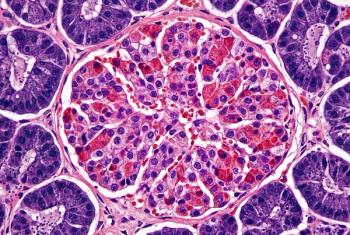
Celiac Disease and Thyroid Disease in Adolescence Linked to the Development of Type 1 Diabetes in Adulthood
Key Takeaways
- Adolescents with autoimmune diseases, especially AITD and celiac disease, have a higher risk of developing T1D in young adulthood.
- The study found a hazard ratio of 2.19 for T1D among individuals with autoimmune diseases compared to those without.
Type 1 diabetes, celiac disease, and Hashimoto thyroiditis are all strongly associated with HLA class II genes, authors of an observational study that found links among the diseases.
Adolescents who are diagnosed with certain autoimmune diseases appear to be at a heightened risk of developing Type 1 diabetes (T1D) in young adulthood, according to a new report.
“The need to identify risk factors and better define the population at risk for T1D stems from the rising incidence reported in many Western countries, the need to minimize misclassification of diabetes type in adults, and the recent availability of medical therapies that may delay T1D onset,” they wrote.
The investigators decided to use a nationwide, population-based retrospective cohort of more than 1.4 million people between 16 and 19 years of age who had no history of dysglycemia and who underwent a medical evaluation before beginning mandatory military service in Israel between the years 1996 and 2016. The investigators then compared the data from those preservice medical evaluations against adult-onset T1D data from the Israeli National Diabetes Registry.
At baseline — in this case, upon entry into the military — 2.7% of cohort members (38,766) had a history of autoimmune diseases. The most common types of autoimmune disease within the cohort were autoimmune thyroid disease (AITD; 10,333 patients) and celiac disease (9,603 patients). After a follow-up period amounting to more than 15 million person-years, the investigators found 37 incident cases of T1D among patients who had autoimmunity at baseline and 740 incident cases among those without autoimmunity at baseline. That translated to a crude incident rate of 9.6 cases per 105 person-years in the autoimmune cohort and 4.8 cases per 105 person-years among those without autoimmune disease at baseline.
A subsequent multivariable analysis that adjusted for age, birth year and socioeconomic status found that the hazard ratio for incident T1D among people with autoimmune diseases was 2.19 compared with patients without autoimmune diseases at baseline.
The authors found that the crude incidence of T1D among people with baseline AITD was 17.7 per 105 person-years, and the crude incidence of T1D among those with celiac disease was 11.3 per 105 person-years.
The investigators said those two autoimmune diseases represented the main drivers of the increased risk of T1D among those with autoimmune diseases at baseline in their cohort. However, they said there were insufficient numbers of cases of other autoimmune diseases to fully assess how they affect risk. They noted that some autoimmune diseases have shared risk factors with T1D.
“T1D, celiac disease, and Hashimoto thyroiditis [are] all strongly associated with HLA class II genes — particularly HLA-DR3-DQ2 and HLA-DR4-DQ8 — which predispose individuals to multiple autoimmune conditions,” they said. “...Moreover, T1D, celiac disease, and Hashimoto thyroiditis are organ-specific autoimmune diseases, primarily mediated by CD4+ and CD8+ T cells targeting discrete tissues such as pancreatic β-cells, intestinal villi or thyroid follicles.”
The authors conceded that their study was observational in nature, but they said its findings are similar to other studies. They said their data might also be used to target screening for T1D among people with celiac disease or AITD. Such preemptive screening may decrease the likelihood of diabetes misdiagnosis in adults.
Newsletter
Get the latest industry news, event updates, and more from Managed healthcare Executive.



















































